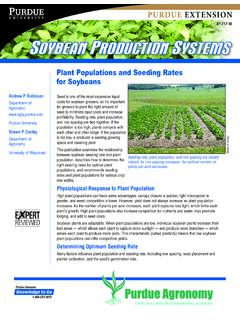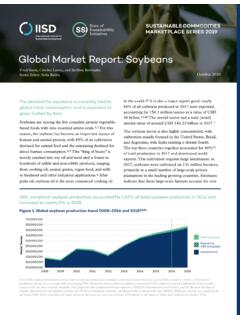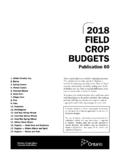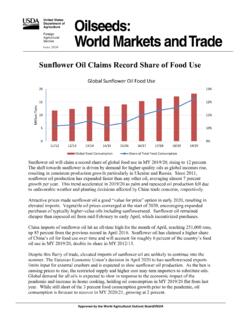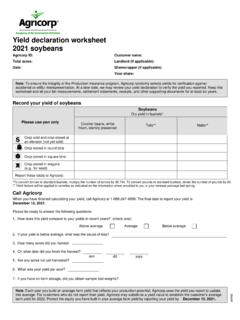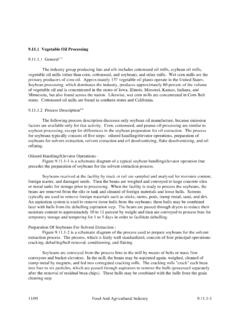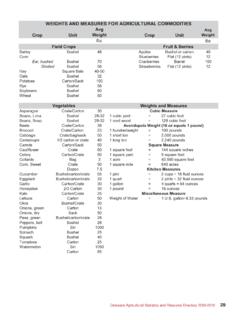Transcription of SOYBEANS - Food and Agriculture Organization
1 SOYBEANSPost-harvest Operations - Post-harvest CompendiumSOYBEAN: Post-harvest Operations Page 1 SOYBEANS : Post-harvest Operations Organization : Centro de Investigaci n y Desarrollo, (CIAD) ( ) Authors: Islas-Rubio, PhD, I. Higuera-Ciapara, PhD, General Director and Edited by AGSI/FAO: Danilo Mejia, PhD (Technical), Beverly Lewis (Language & Style) Last reviewed: 07/06/2002 Contents Preface .. 2 Economic and social impact of SOYBEANS .. 3 World trade .. 4 Primary products .. 8 Secondary and derived products .. 8 Requirements for export and quality assurance .. 9 Consumer preferences .. 13 2. Post-Production Operations .. 17 Pre-harvest operations .. 17 Harvesting .. 21 Transport .. 24 Threshing .. 26 Drying .. 26 Cleaning .. 31 Packaging .. 32 Storage .. 33 Processing .. 38 3. Overall Losses .. 45 4. Storage Pests .. 52 5. Economic and Social Considerations.
2 58 Overview of costs and losses .. 58 Major problems .. 61 Proposed improvements .. 62 Small-scale technology .. 62 Fortification of staple foods with 62 Modifications to soybean cultivars .. 62 6. References and Further Readings .. 63 7. Annexes .. 70 Annex Table A1. Pesticide tolerances in soybean and soybean products.. 70 Annex Soyfood recipes .. 75 Annex Quotations and Technical Specifications of Thresher Machines .. 93 soybean : Post-harvest Operations Page 2 Preface The flow of grains from the field to consumers includes several operations, whose sequence and interactions contribute to the formation of a complex system named "the post-harvest system". All of these operations should be appropriately done in order to reduce the risk of altering negatively the condition of the grain, that is, its quality. SOYBEANS growers do their jobs cultivating the land and harvesting the crop at optimum maturity.
3 Sometimes, it is necessary to pre-dry the produce before the subsequent threshing or shelling operation. Afterwards, the grain must be cleaned and dried, so that it can be stored or undergoes further processing. soybean , as any other grain, can be stored in bulk or in bags, on the farms where it is produced, in collection centres, or with storage agencies. Finally, soybean is sent from the warehouses to markets for sale to consumers, to small-scale food processors, or to agro-food industries. In the past, the gathering and storing of ripened crops was generally a slow and arduous task, today the reverse is usually the case, because of the availability of harvesting machinery and handling and loading equipment. Harvesting should be done in the shorter time possible to avoid grain condition changes that might affect its conservation and storage. In developing countries, there are still many farms, often the small farms, where insufficiency of knowledge and of machinery, equipment, labour and storage facilities, make it difficult to proceed in the right manner, with the result that storage is not always successfully accomplished and the quantitative and qualitative losses are high.
4 In some regions of Africa and Latin America, overall post-harvest losses of cereals and grain legumes between 25 and 50 percent of the quantities harvested are estimated. Grain losses in the tropical and subtropical regions are also high since the tropical conditions accelerate the growth of insects, fungi, mites and rodents and provide optimum conditions for their development through most of the year. In addition, the lack of economical resources in these regions to invest in constructing the appropriate storage facilities contributes to higher grain losses. There is a lack of reliable data on the level of soybean post-harvest losses. It is possible to increase the amount of SOYBEANS available for the market without increasing the number of hectares dedicated to this important crop. There are several ways to do it, but none of them is easy. One of them is reducing SOYBEANS post-harvest losses by improving the actual post-harvest systems.
5 Another is increasing yield by implementing an integrated pest management to control plant diseases and insects, or by using disease-resistance and insect-resistant cultivars, or by using transgenic seeds conferring tolerance to a certain herbicide or resistance to insects. This chapter entitled SOYBEANS Postharvest Operations as a part of the INPhO Compendium on Post-harvest Operations intends to provide up-to-date information regarding one of the most important crops in the world, as well as the traditional and improved techniques used to carry out the operations in the post-production chain. Whenever possible, losses and work division within the family associated to soybean post-harvest operations will be provided. Chapter 1 (Introduction) gives a general overview of the importance of the post-harvest system, economic and social impact of SOYBEANS , world trade (production and marketing), primary, secondary and derived products, requirements for export and quality assurance and consumer preferences.
6 Chapter 2 gives the post-production operations, including pre-harvest and harvesting operations, transport, threshing, drying, cleaning, packaging, storage and processing of SOYBEANS . Chapter 3 discusses overall losses distinguishing among quantitative and qualitative losses whenever possible. Chapter 4 describes pest species more frequently found in soybean after harvesting, prevention and control. Chapter 5 is devoted to economic and social considerations with emphasis on costs and losses at different stages, major problems facing small and medium-scale farmers. References are listed in Chapter 6. soybean : Post-harvest Operations Page 3 Chapter 7 includes an Annex containing a complete list of pesticides used to control soybean pests during its cultivation, handling and storage. A good number of traditional recipes and other recipes that include SOYBEANS exclusively or in some extent are provided in the Annex, whenever possible the country in which the recipe originated is given.
7 Also, the Annex contains the list of figures and tables. SOYBEANS Postharvest System intends to be a reference for anyone interested in SOYBEANS , food technologist, nutritionist, academic and governmental professionals, students and for people dealing with soybean at any stage of the post-harvest system. We wish to express our sincere appreciation to Food and Agriculture Organization of the United Nations (FAO) for selecting our Institution (CIAD, ) and particularly to us, to write this chapter for the InPhO Compendium on Post-harvest Operations. We also express our gratitude to those who kindly accepted our interviews and shared with us their experience in any of the multiple activities that have to be done to make SOYBEANS or soy-base foods available to consumers. We are grateful for the support provided by our families and Elsa Bringas Taddei to carry through this commission. Economic and social impact of SOYBEANS soybean crop is undoubtedly of a great economic and social importance worldwide.
8 soybean provides about 64 percent of the world s oilseed meal supply and is the major source of oil, accounting for about 28 percent of total production (USDA, 2000). In 1999, SOYBEANS represented 52 percent of world oilseed production and 46 percent of those SOYBEANS were produced in the United States on a surface of about 30 million hectares, representing a crop value of US$ billion. Fully 60 percent of the world s soybean trade originated from the United States. For countries with surplus soybean production this crop represents an important source of foreign currency, such is the case of Brazil and Argentina in Latin America. In Argentina, the soybean complex contributes with more than 50 percent of the export currency (Ploper, 1997), whereas in Brazil the soybean complex generates yearly US$ billion in income and earning about US$ billion in foreign exchange (Duque, 1999). On the other hand, for countries with a consolidated soybean crashing industry but insufficient amount of domestic SOYBEANS to produce the soybean meal demanded for the broiler, pork and aquaculture industries, soybean exports are indispensable for keeping the actual labour force and remaining in business.
9 Mexico has been in this situation for several years. In 1998, Mexico imported about 4 million metric tonnes of SOYBEANS and 150 thousand tonnes of soy meal with a value of and million dollars, respectively (Feedstuffs, 1999). In some developing countries, especially in rural areas, soybean represents the best protein source available for improving the nutritional value of traditional foods (Bressani, 1974; Vaidehi et al, 1985; Verma et al., 1987; Seralathan et al., 1987; Akpapunam et al., 1996; Sheralathan and Thirumaran, 1998). Also, the crop has revolutionized the rural economy by raising the living standards of soybean farmers, especially the women and children (Paroda, 1999). In some regions of Asia, soybean crop sales represents between 30 percent and 60 percent of the average cash income, which is used to buy material inputs for the next crop (rice cultivation), Lancon (1997). In the Far East countries and some other countries with a large Oriental population, soybean is an essential part of the diet.
10 In 1994, the worldwide market for food beans was estimated at least at one million metric tonnes (Shurtleff, 1994; Motoki and Seguro, 1994). Research findings in the last decade about the benefits of soy-based foods to prevent and treat cancers and heart disease may contribute to higher soy-based food consumption, especially in the West. soybean : Post-harvest Operations Page 4 The introduction of soybean crop to several countries have led to a shift in their cropping systems from a monocrop (post-rainy wheat or other crop) to a soybean -wheat or soybean -other crop system. This cropping system change has resulted in an enhancement in the cropping intensity and resultant increase in the unit area profitability from the land use (Paroda, 1999). soybean crop is seen to be useful for the sustainability of the major cereal based cropping systems in the world. World trade World soybean market data are shown in Tables 1 through 6.










